

While brainstorming on how you could further expand your business, a statement from other entrepreneurs suddenly slipped your mind. You always hear them saying how easy it is to register a franchise – all you need is an Operational manual! Oh, that sounds like a piece of cake! An Operational manual – you have a clear vision of it in your mind, so all you need is just to express everything into words. You are ecstatic, you are ready to dive into this new adventure of franchising! So to make your vision a reality, you started hiring copywriters to help you write down all your SOPs, or also known as the Operational Manual. They come to your office to know more about your operations, they did interviews with you to help in their process. There you finally had it in your hands, your own Operational Manual. However this didn’t end well for you. Yes you have an Operational Manual, you invested time, you invested money; but your people are not following it! No one understood it. If you wrote it yourself, things might end up being the same, because neither you nor your staff are trained in producing an Operational Manual. Things do not seem to be THAT easy after all, huh?
Humans: the smallest unit of any business around the world. Everything starts with the involvement of people; so, under any circumstances, you would still need people in your business. When you’re selling your business, who are you selling it to? People! Therefore, in order to expand your business, the process of duplicating your people is essential – be it your own people, or even your customers. You expand your business by selling more, or selling at a higher price. See, if you sell something all by yourself, would you be able to sell more? There would be a particular threshold you are not able to exceed because it is more than your capability, right?

But with more money, more profits, you could help your business grow. With all that money, at this point you may start considering expanding your business units, a process called franchising. You want to duplicate your successful business units, continuously attracting investors and other bosses and helping each other make money.

People are the total opposite of robots, they need to be instructed to get moving, or sometimes they may do the opposite of the instructions because it benefits themselves rather than the organisation. In the circumstances of having new people to work, how are they supposed to know what should be done first? Since you are the boss, it is your responsibility to lead them; but this is only applicable in smaller business. How about bigger companies? Managers would be responsible then – but is your manager capable and trained well enough to lead the newcomer? If they cannot, then YOU need to teach; are you ready for that? To teach, to lead, to guide your people with zero mistakes? You might appoint a Human Resources manager to aid you in this problem, but how sure are you that the new people coming into your business are there to solve problems instead of creating more of them? This is why you need a business system that makes full sense to you. A system that works as a step-by-step guideline to help you in automating your business and to duplicate your people with no stress.
Louis, being in the industry for more than a year, sells homemade ice-creams. The recipe of his ice-cream is so unique and delicious, and it sells like hot cakes every single day. This only branch of his business is very successful. With this trade secret, Louis makes lots of money with no stress at all. The success of his business started opening the eyes of investors, who were willing to pump in money so that Louis could expand his business. The investors had a strong liking towards Louis’ product and they were confident that his business is ready to do well in other places too due to its specialty.
Louis took up the challenge, and therefore he started hiring a copywriter as the first step to expanding his business. He had the copywriter’s help to set up a prototype of his business’ operations. SOPs were generated, and Louis tried implementing it in his current business. Unfortunately, his people were not able to follow it. In addition to that, Louis also hired a franchise consultant. This was to no avail as well. All the consultant did was just take the copywriter’s work and immediately registered Louis’ business as a franchise. It was so simply done just for the sake of registering the franchise.

“No no no, this is all too wrong’” Louis thought as he discovered how the prototype still had lots of flaws because people were not following them – something was wrong with the quality of it! Louis decided to take a step back by deciding not to sell to the franchisee. It was too soon, he didn’t want any further risks to happen. Therefore, to learn how he could make the prototype better, Louis attended seminars together with his managers to be trained on the matter. They then tried to redo the SOP but still, they did not know how to write. They were not able to turn their theoretical knowledge of writing SOPs from A to Z into technical skills! One day, Louis came across a CFO with a strong franchising background. With the CFO’s help, Louis and his people were re-trained and they even generated a new SOP together. Within a month’s time, the whole system was finally up.
An Operational Manual, YOUR company’s own encyclopedia – a documentation containing every single bit of information on how you could operate your business by explaining the procedures and processes. A system that helps your business grow one step closer towards flawless automation and successful duplication of your people.
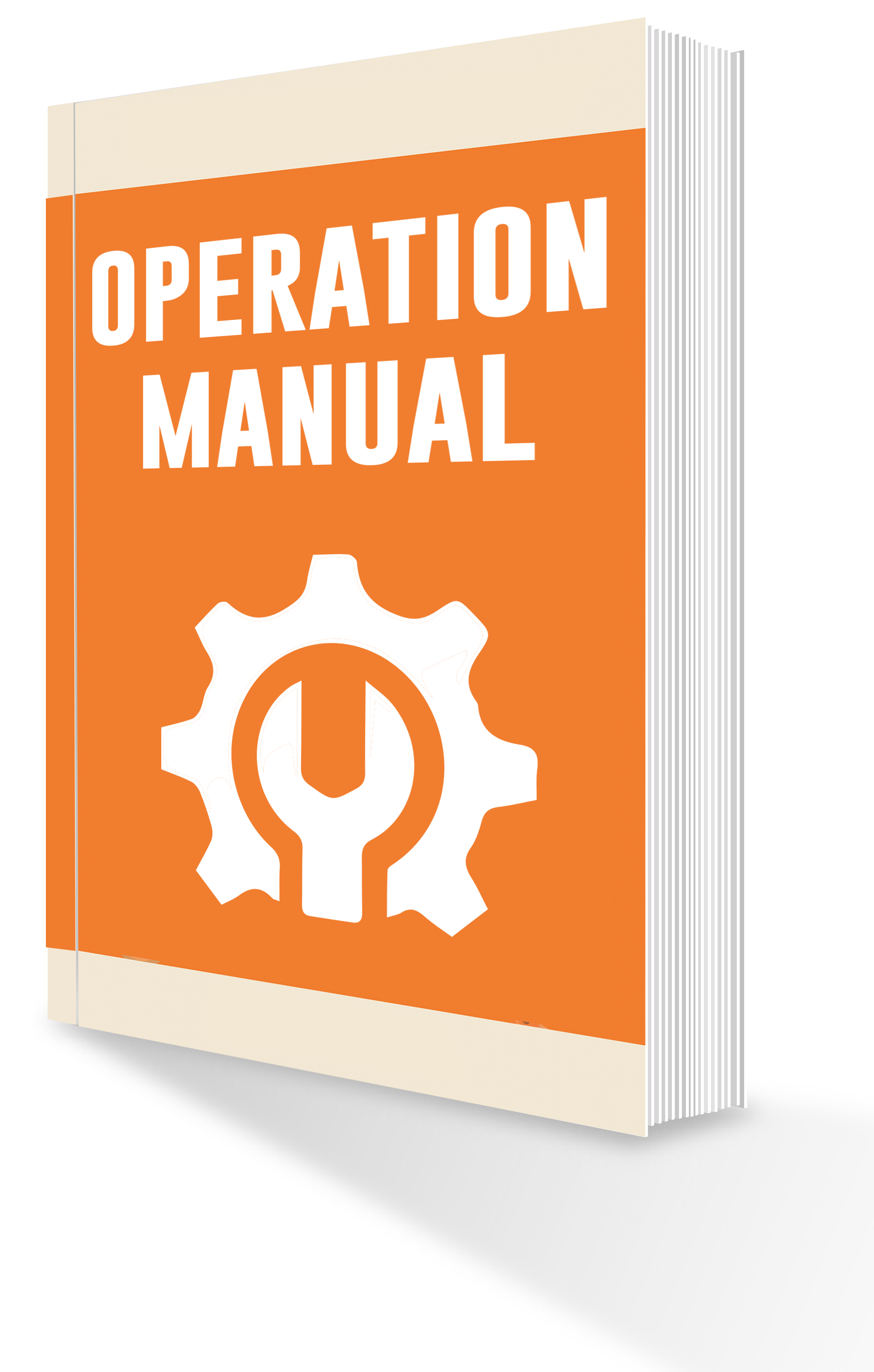
Generating your own Operational Manual does require you to invest a lot of time, energy, and money. However, this is a one-time process as once you have finalised your Operational Manual, gives your business the benefit of a lifetime. So yes, your investments in time, energy, and money are guaranteed to be worth it. You must be curious what method is reliable in generating your own Operational Manual, right?
You shall now be introduced to the Coding FormulaOn™, a self-developed system that uses symbols to represent the meaning of the same outcome. This system, consisting of seven sections, would be your best companion to help you come up with an Operational Manual that helps you on your franchising journey.
Section 1 CFO: Organisation chart of job list
You need to find out all the jobs in every department of your business. This is where you classify the jobs according to priorities and duplication. An organisation chart is created, but consists of only jobs, no people. Just focus on the job, because the title of a person does not represent THEIR JOB.
Section 2 CFO: Process flow of job task
When your people are too used to following instructions in working from beginning to the end, they would not know how to write. They find writing a process flow such a tedious process and very time consuming. In fact, it actually only takes 3 minutes to do one process flow on a piece of paper. This is to outline a similar communication pattern and produce the same outcome in the company. Yes, it is that simple! Don’t believe me? We will get back to that in a later section of this chapter.
Section 3 CFO: Ultimate checklists
In blog “How to Train Talents Systematically and Effectively?”, we have mentioned that job mistakes come in two kinds: (i) cluelessness, where the person does not have the knowledge or skills to get things done right; or (ii) carelessness, where a person is competent but just not able to do things right. Carelessness is caused by forgetfulness, due to a poor memory. Remember that a human brain could only retain a maximum of 7 things at a time? Their performance will be affected due to this, as their ability is significantly reduced by their negative emotion. Thus, a checklist is the perfect tool to tackle the problem of ongoing job mistakes. It outsources the brain memory and makes it more reliable than merely just experience.

Section 4 CFO: Template swim flow chart
Would you prefer an explanation in the form of photos, videos, or a book? Well, the best representation of your processes is using visual means. It makes your processes easier to view and understood compared to reading nothing but plain text. Even by listening, a person would have a tendency to forget everything.
So use a flowchart, or in other words, a diagram which represents the movements of a process in sequential order. It is represented by 7 common shapes: terminator, decision, connector, data (input/output), preparation, process, and document or report. Make your flowchart even better with a template, or a guide to your process, e.g. pictures, short videos, screenshots, forms, or samples.

Section 5 CFO: Foolproof SOP
When an SOP is too detailed and complicated, it becomes a disadvantage because it will make your people have a hard time understanding the manual. Worse still, when you said it is impossible to complete, and it is very long to describe it. A perfect SOP is one that is foolproof or dummy proof. It is a combination of your process flows, flowchart, and templates. You only describe what is necessary to your audience, not to yourself.
Section 6 CFO: Play the role of trainer
Having an SOP then dumping it to your people won’t resolve any of your problems. You need to be the trainer. Play the role 100% because to teach is to learn. You know the flaws of your operations as you teach. Remember when we mentioned this in blog “How to Train Talents Systematically and Effectively?”
Section 7 CFO: Panel of operational manual
In a company, an SOP is the equivalent of the Road Transportation Law for driving. What happens when people do not follow the law on the road? The loss of property and lives will occur. Thus, an SOP represents your company’s soul. You will need a panel, or a committee which helps you moderate your operational manual to make sure you achieve your SOP’s ultimate objectives: do FAST, do MORE, do GOOD. They will be in charge of approving your SOP whenever there are changes or even to analyse issues. This will make your SOP as perfect as possible, i.e. your trade secret to automation.
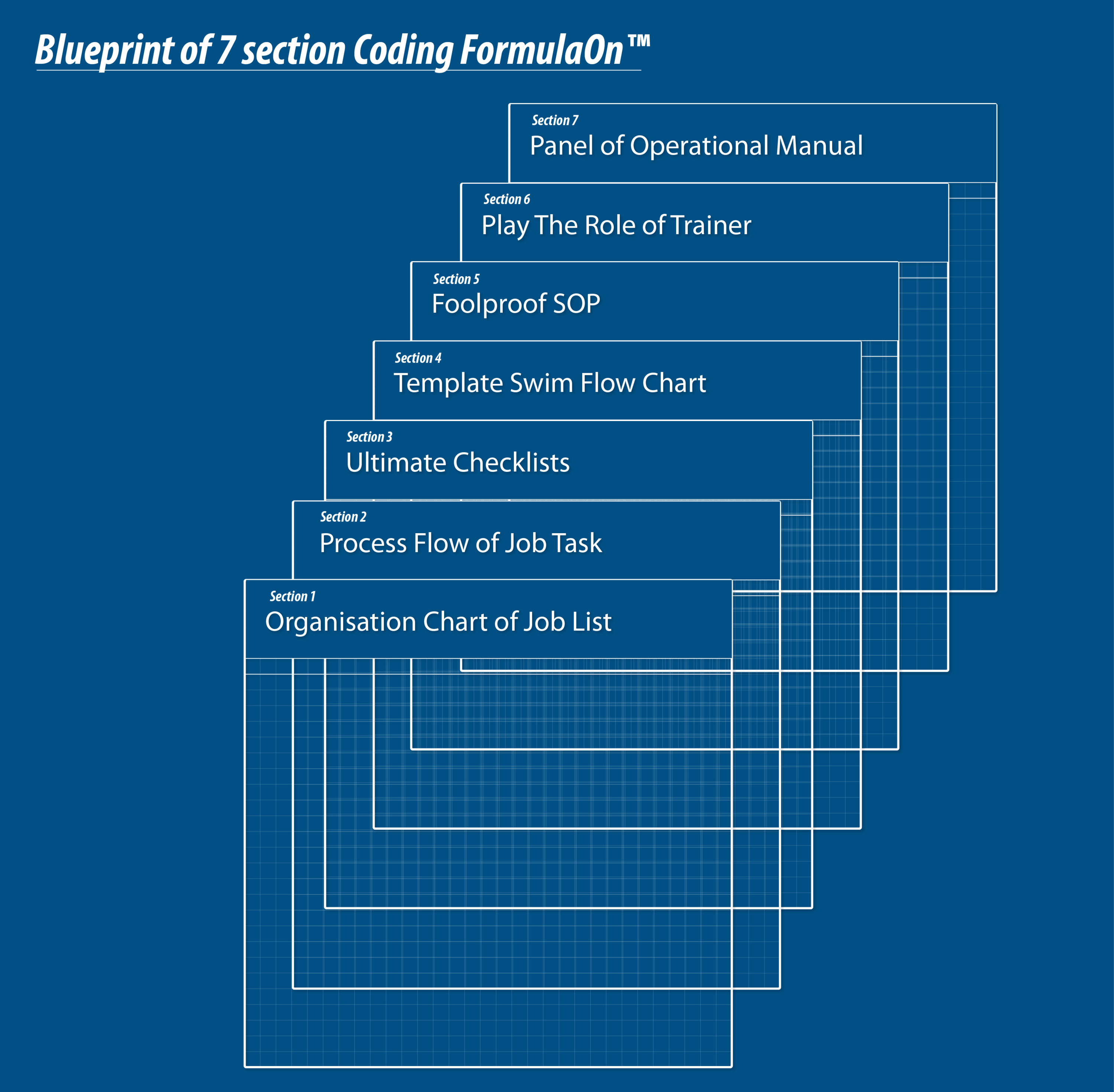
You have the foundation of every section of the Coding FormulaOn™, now let’s get on to serious business – to know in-depth what exactly needs to be executed to come up with the perfect Operational Manual for your business. For a better outcome, involve your people in this process.
Section 1 CFO: Organisation chart of job list
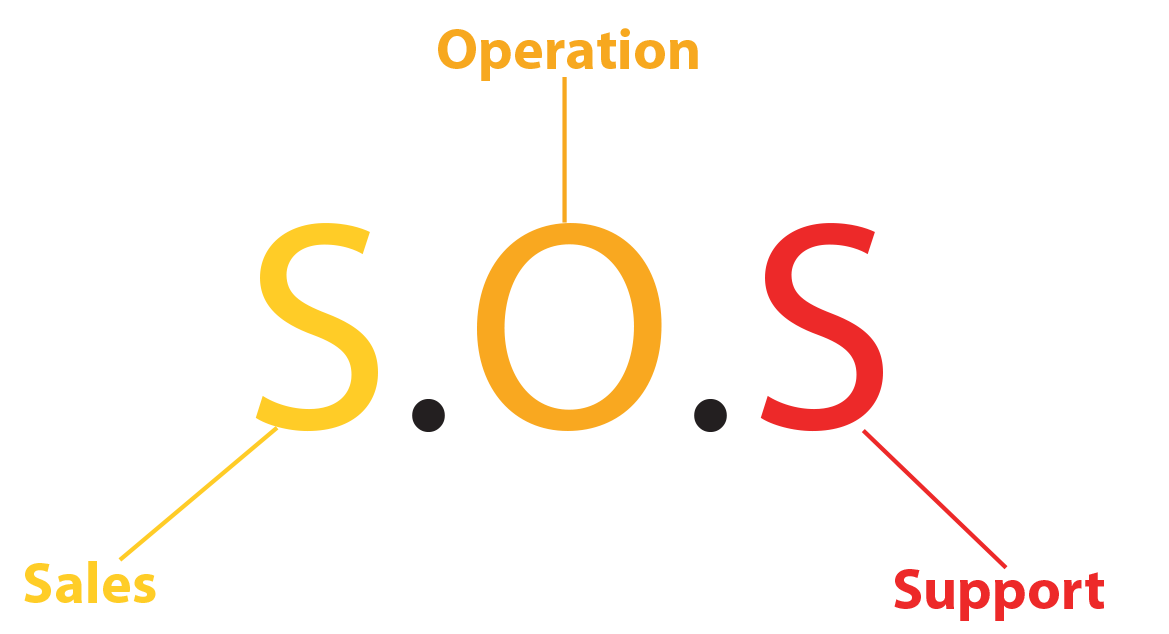
– Coding FormulaOn™: SOS business function
1. Identify your business function using SOS (Sales, Operation, Support), or you could further expand it into SOMFAH in more detail

– Coding FormulaOn™: SOMFAH departments
1. Highlight SOMFAH department job list and create your job list.
a. S = Sales; O = Operation; M = Marketing; F = Finance, A = Accounts & admin, H = Human resource;
2. With a SOMFAH checklist, understand all the types of jobs in your business.
3. Tick items you are certain your company has.
4. Circle items that you are directly or indirectly involved in.
5. Write down your minimum 10 jobs in a day or in a week.
6. Refer to the circle in #3 or copy directly from the circled items.
7. If you have more than 10 jobs, keep writing after training as homework.
8. At your Job List, indicate the Coding FormulaOn™ next to each job.
– Coding FormulaOn™: Job PRIORITIES
1. JOBs are to be performed at the end of the day, week, months, or even per quarter. They will have different priorities.
a. $ = Job incomplete will affect money of a company
b. R = Job is often Repeated, especially daily and weekly. It keeps recurring.
c. * = Job is complicated, not easy to explain in words and how to complete it requires good judgement.
2. Use the symbols from (a)-(c) above next to each job in the Job Checklist, to indicate what they represent.
3. The symbols can be used individually or even combined to represent priority, in the following order: (i) $R*, (ii) $R, (iii)$*, (iv) *$, (v) $, (vi) R, (vii) *, (viii) nothing.
– Coding FormulaOn™: Job ENDTIME
1. Time to complete a job varies, where it can be at the end of the day, end of the week, bi-weekly, monthly, quarterly, event, etc (on request)
2. Therefore the Coding FormulaOn™ = D / W / BW / M / Q / ETC / EV
3. Write the Coding FormulaOn™ next to each job list.
– Building Departmental Organisation Chart with job list
1. Transfer the job list into the Departmental Organisation Chart of each member according to prioritisation.
2. Require your people to explain what they learnt and what they see in the company.
3. Compare all of the job lists and have a discussion to get the best final version for the company.
4. Select a DRI (Direct Responsible Individual) from your company using D / M / E / A (Director / Manager / Executive / Assistant) to each job in each department and eliminate different names used by each member, or wrong categories of time and department and numbers of jobs for each department. Remember, the position and title do not represent the things you do; it’s the task nature that counts.
– Job Staff List (head over to blog “How to Train Talents Systematically and Effectively?”)
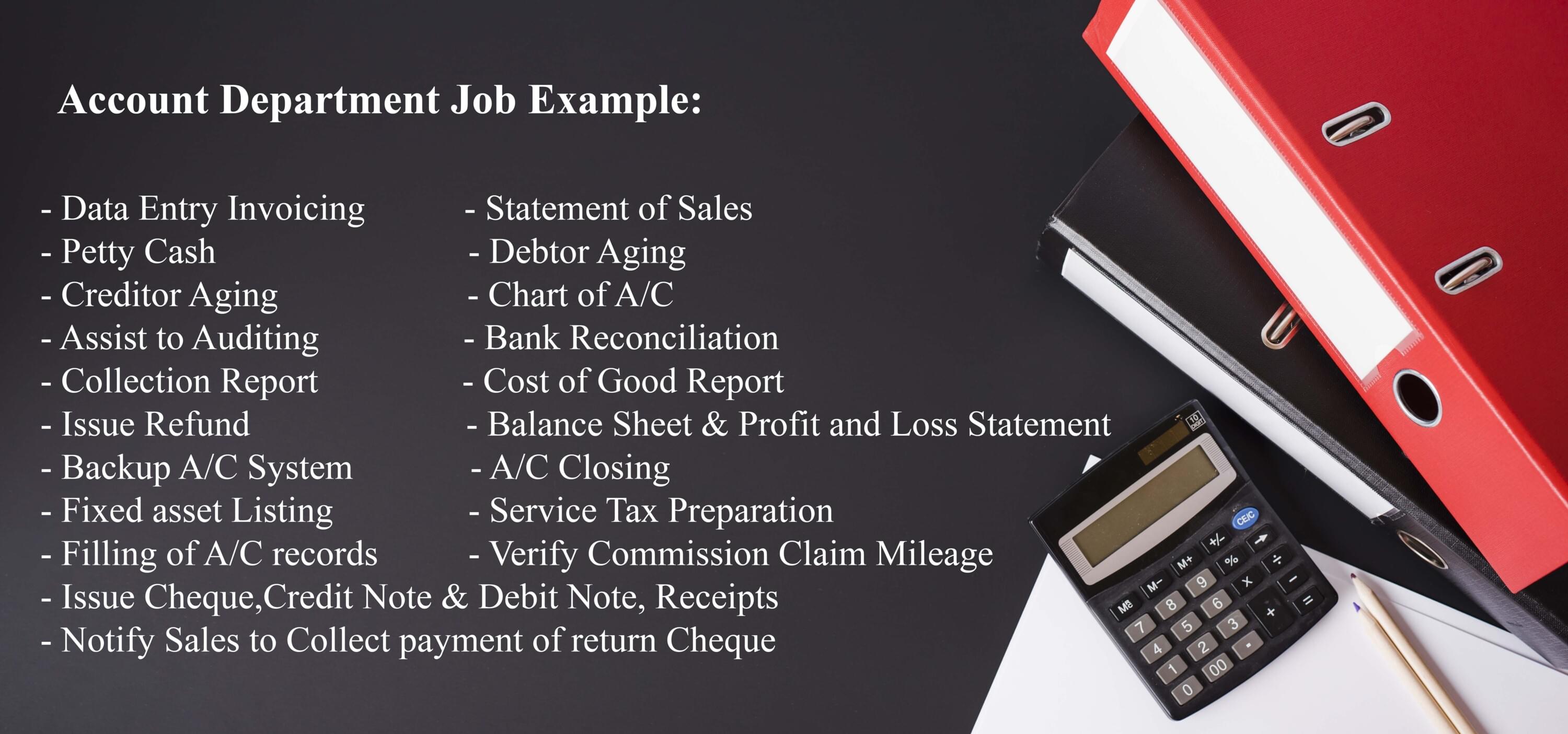
Section 2 CFO: Process flow of job task
In this section you will generate a job description that makes sense using codes, a Coding FormulaOn™ for a JOB: [Department job numbers] – [End department] – [Complete TIMELINE] – [DRI]. An Originate End Flow method (as in blog “How to Train Talents Systematically and Effectively?”), will help you a lot on this.
Now, separate a paper into four quarters: Q1, Q2, Q3, Q4. Each quarter here represents a different item as follows:
– Q1: Complicated to Complex
1. Write 3 key words of each task, keep it as short as possible and let the maximum number of tasks be 9.
2. Use an Originate End Flow method: Write the job name, then number each step, where step = task. Refer blog “How to Train Talents Systematically and Effectively?” for more information
– Q2: Complex to Complete
1. Coding FormulaOn™: SOMFAH
a. If each TASK is not cross-department, use the same department.
b. If a TASK needs other people from different departments to help, this means there is a cross- departmental event. Indicate it.
2. Coding FormulaOn™: ENDTIME of completion
a. Add ENDTIME to complete a job based on D / W / BW / M / Q / ETC / EV
b. Write the code next to each task
3. Coding FormulaOn™: DRI (Direct Responsible Individual)
a. Junior needs to be always ready to take on the job and tasks of the superior.
b. DMEA represents the DRI; write the code next to each task.
– Q3: Complete to Clear
1. From Q1, copy each line as a coding for each task from bottom to the top of Q3. Make the coding clear.
2. Coding FormulaOn™: JOB
a. Full job code is made of the end of the steps.
3. Coding FormulaOn™: TASK within a JOB
a. Rephrase: (i) Write job name, (ii) Job numbers, (iii) Steps numbers, (iv) Department code, (v) ENDTIME code, (vi) DRI code
b. Example: A20 – 7 – A – W – (M)
4. Hear explanations from members on what they learned and what they see in the company.
5. Ask: What would you feel if the job and code is without human touch and emotions?
– Q4: Clear to Conscious
1. Write the description of each task consciously.
2. Ask deeper to allow you to understand each task better, or to add or remove the tasks: (i) What to do?, (ii) Who and when to do?, (iii) How to do?, (iv) Why and how it is done?
3. Arrange each person to do the Process Flow Job Task based on their own job list.
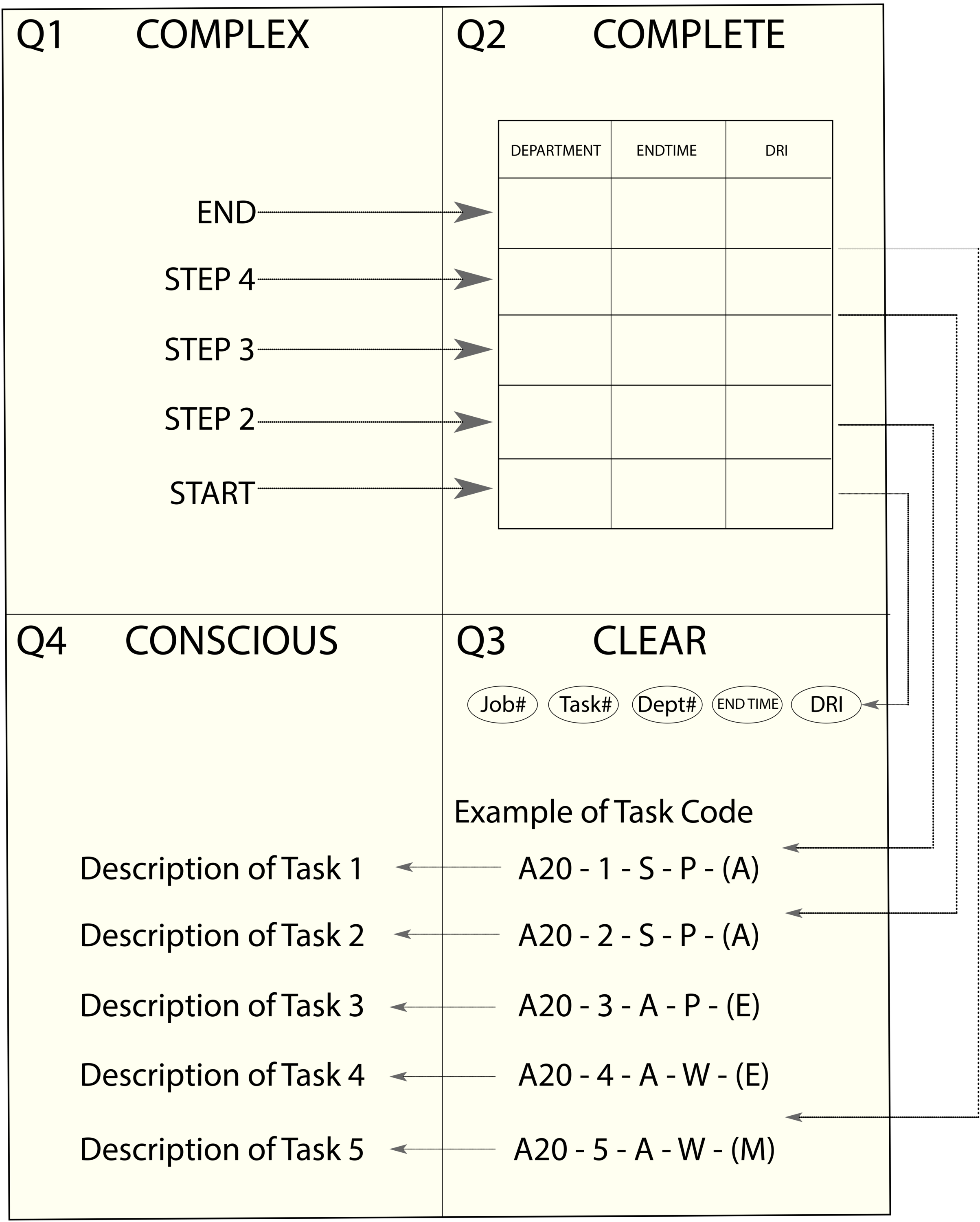
Section 3 CFO: Ultimate checklists
1. Know the types of checklists: (i) Execution Checklist, (ii) Audit Checklist, (iii) Q&A Checklist. The HOD and DRI are essential people in the Execution Checklist, as they ensure every job and task are done in your company.
2. The Head of Department (HOD) is responsible for collecting SOMFAH’s Job List. Therefore, discuss and appoint the best HOD.
a. Fill up the departments and schedule in the HOD checklist.
b. Copy the JOB code from Process Flow Job Task into HOD checklist.
c. Complete Process Flow Job Task according to priority.
d. Give homework! To allow them to have a clearer understanding. Let them do the final HOD checklist and unfinished Job Process Flow.
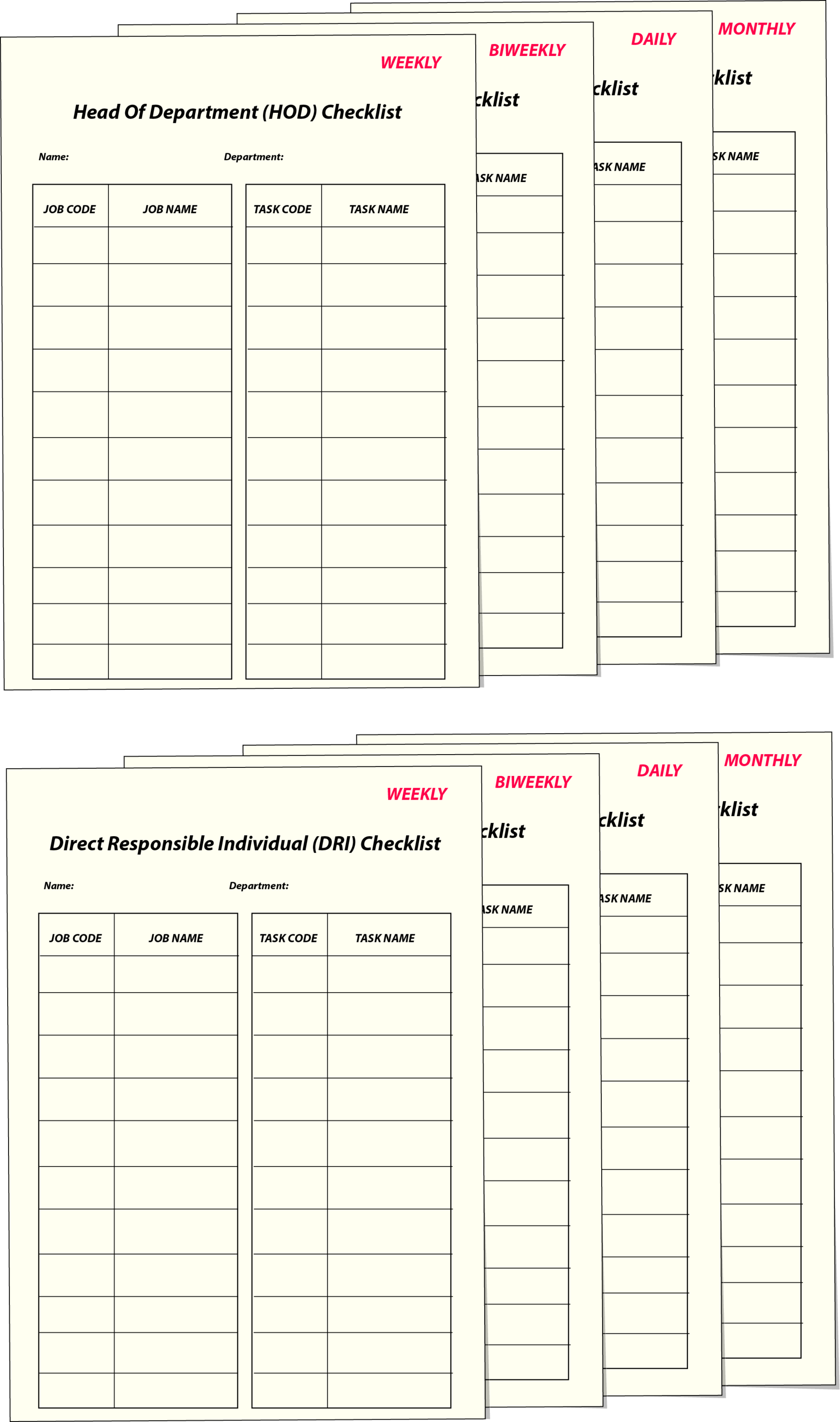
3. As for the DRI:
a. Fill up the departments and schedule in the DRI checklist.
b. Copy the TASK code from Process Flow Job Task into the DRI checklist.
c. Homework: Do DRI checklist and unfinished Process Flow Job Task where TASK code is written.
Section 4 CFO: Template swim flow chart
1. Use an A4-sized paper to draft your Flowchart before jumping into using a software.
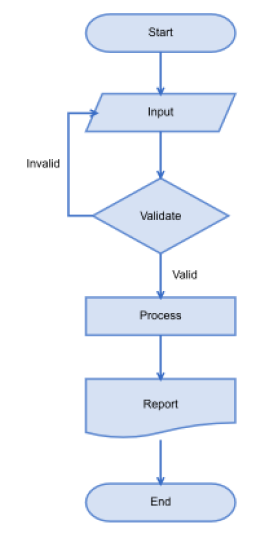
2. For each step, choose 1 of the 7 SHAPEs.
3. Write 3 words MAXIMUM for the steps.
4. Ask Y (yes) or N (no) to flow back or go in another direction.
5. Put TASK code on each shape.
6. Bring an A4 and draw 1 of your process flow to a flow chart.
7. Golden rule: Process flow → Flow chart → Template
8. Use a SWIMLANE FLOWCHART (when dependent of other departments)
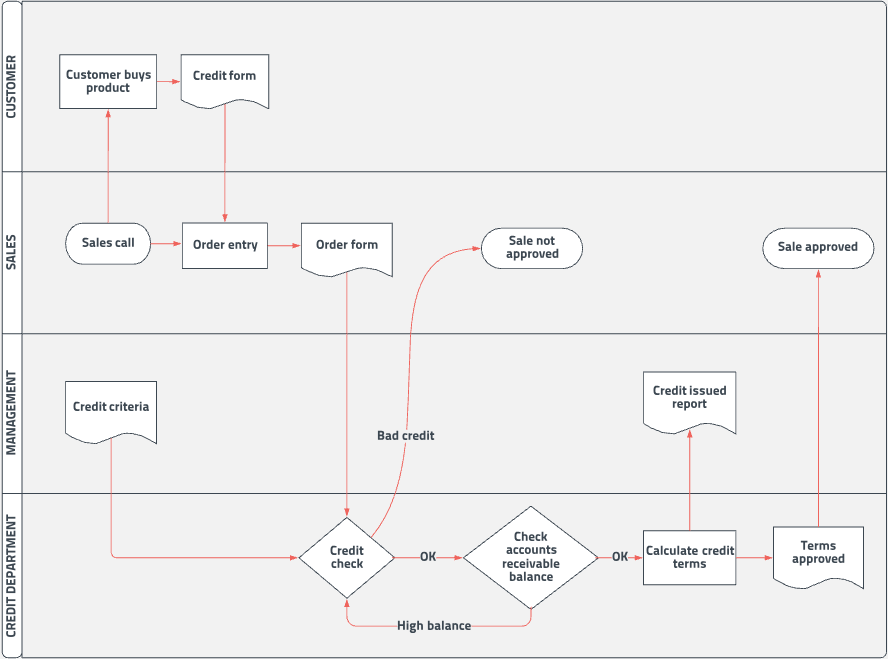
a. Flip the paper into 1/2 or 1/3 and draw from left to right.
b. Each step, represent by only 1 shape.
c. Write 3 words MAXIMUM for the steps.
d. Ask Y or N to flow back or go in another direction.
e. Put TASK code on each shape.
f. Bring an A4 and draw 1 of your process to a flow chart.
9. Add TEMPLATE
a. Who is your audience? Do they have the knowledge to understand your process flow or flow chart? What will help the audience to understand better?
b. Help them by adding the template to your TASK.
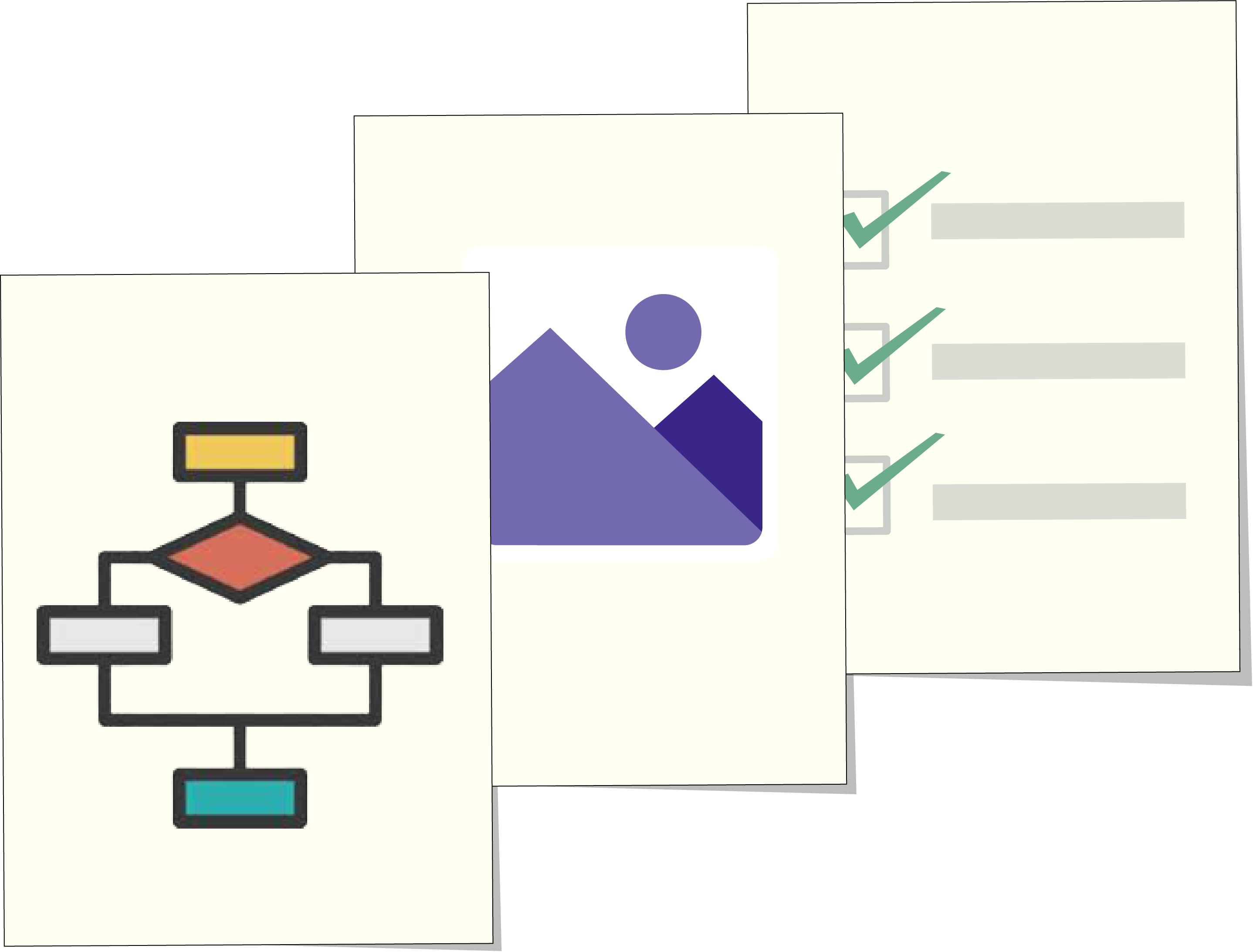
Section 5 CFO: Foolproof SOP
1. Use the 5W2H (whay, what, where, when, who, how, how much?) method to think and evaluate the SOP that consists of the process flow and flow chart.

2. Use it to ask around and check with your people if the SOP is missing any important details to be presented to NEW staff.
Section 6 CFO: Play the role of trainer
Be the trainer and train your people (trainee) on how to play the role and here is the following series of questions and answers:
1. Q : What is the job you are presenting? Please describe it specifically.
A : My job is _______________.
2. Q : Why are you doing the job in this way?
A : My work can help solve the problem of _______________.
3. Q : How many steps do you have in your job?
A : There are a total of _______________ steps in the job.
4. Q : How does the job start? Who did you receive it from? To whom it will end? Anyone
else involved in your steps? When does it need to be done?
A : At the beginning, start from _______________, then . . . . .
5. Q : Which step is the most important task, and why?
A : The most important task is the _______________ step, because _______________;
while the consequences caused by a mistake are _______________.
6. Q : Are there any samples or templates for your steps? Is there a checklist?
A : In the _______________, my template is _______________; and this is my checklist,
namely _______________.
7. Q : Is there a possibility of error in the steps or checkpoint in your job? If so, is there a
return flow of the steps/tasks when the checkpoint fails?
A : In step number _______________, the checkpoint is _______________. If I made a
mistake, I need to do _______________.
8. Q : What is your ultimate goal for the job? What is the END point?
A : After the work is completed, it will _______________.
Section 7 CFO: Panel of operational manual
1. Assign 3 persons to be in the panel (GM + HR + HOD), according to the 3 ultimate objectives (FAST, MORE, GOOD).
2. Use the power of the majority to improve, add new, or even drop out the SOP in the panel meeting.
3. Allow a quarterly review of the operational manual to be done by the HR, and a monthly review by the HOD.
4. Whenever a job goes wrong, refer back to the operational manual to see if it is correct. If any changes need to be done to the SOP, do it.
5. Ensure the operational manual is resilient, is in a loop, and is self-organisational – where under any circumstances changes could be easily made, or could be easily referred to when something goes wrong. Make sure there is congruence among all your people and a hierarchy (GM – HOD – DRI (Staff)) is clearly outlined to allow easily reporting based on the SOP.
6. To create a franchise manual, pick the most important characters out of the SOMFAH to franchise the units.
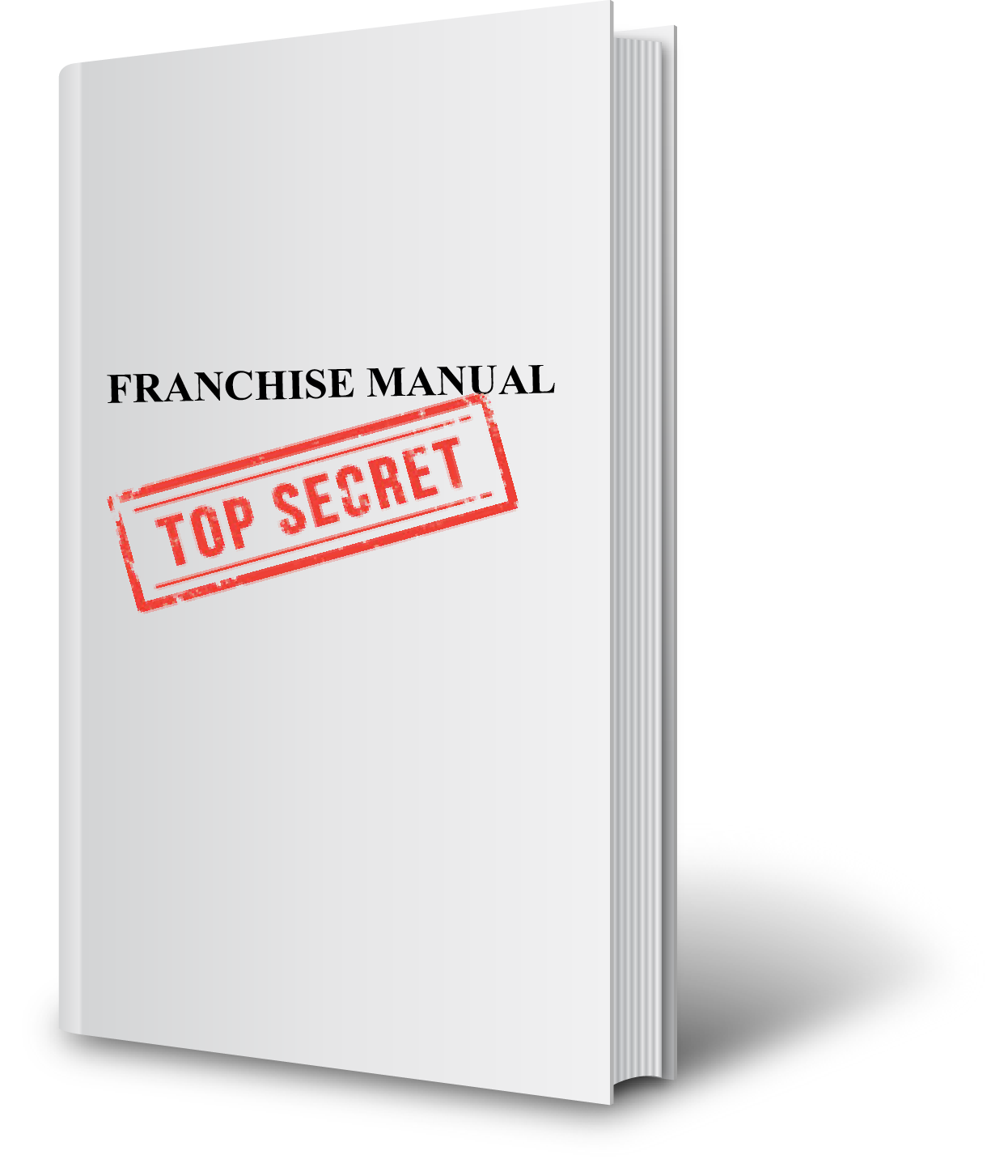
“Why should I use the method if I don’t even have any plans to franchise my business?”, this may be one of your biggest arguments. Yes, not everyone has the thoughts or plans to grow their business through franchising; but don’t you ever dream of opening more branches and have your people help you manage every branch so that you have your ‘me time’ as well? This is business automation, and therefore you could count on me that the Coding FormulaOn™ works perfectly to help you automate your business. From my experience, the method successfully aided in the completion of the franchising process of my clients. It does not just end there, I used it to help in the licensing of my clients’ products and services!
What if you still are unable to duplicate your people after using the Coding FormulaOn™? You can refer to my book NEXT LEVEL BOSS – THE SECRETS or I recommend you to schedule a time with us to do modelling by Coach Stan, i.e. a modelling imitation method. As a Coach, you should do something and then model yourself on how you did it to your people. What’s essential in this process is to separate what is important from idiosyncratic processes, and this is what will make a huge difference. Drop pieces bit by bit to help you find what’s most essential. Please free free to drop us an email cfostan.asia@gmail.com or Whatsapp us at 017-387 6006 to schedule a time to do a coaching session with us.

To wrap things up, let’s go back to Louis’ story. With the CFO’s training and guidance, Louis successfully expanded his business to 9 franchises. With a well-written and understandable Operational Manual, Louis’ business is automated, he could depend on his people to manage his business and he managed to duplicate their good traits from one to another. He was extremely happy from his success, that he has given the CFO some shares from his company and the responsibility to run the business. Louis even sold his master franchise overseas. With the success in business automation, Louis now has more time for himself and his major hobby, diving!
